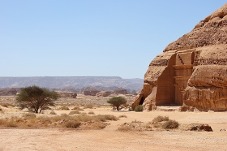Red Sea Research Center - Saudi-Arabia, Thuwal

In September of 2021 I completed the final requirements for my master degree Marine Biology, that I had started two years earlier. However, as my master largely took place during the COVID-19 pandemic I had not yet had the opportunity to conduct research in my favourite ecosystem, coral reefs. Together with my mentor prof. Govers I therefore decided to extend my master with an extra research project. With the help of prof. van der Meij I came in contact with the Habitat and Benthic Biodiversity lab at the King Abdullah University of Science and Technology (KAUST). They invited me to study the habitat mapping applications of drones on shallow coral reefs. For me this was an amazing opportunity, both because of the super exciting research I got to do and because I got the chance to live in Saudi-Arabia for six months. As such, I am very thankful to the Groningen University Fund for supporting me in this project.
By now I have returned to the Netherlands and I can look back on a very fun, educational, and successful internship. For my project I conducted fieldwork in a tropical lagoon within KAUSTs campus. Together with my colleagues I flew a drone over three large reef areas constantly taking aerial photographs. With the help of GPS measurements and an analysis technique called ‘Structure-from-Motion’ I combined all these photographs into three very big, high-resolution photographs called orthomosaics. These orthomosaics can be converted into habitat maps, where each pixel is assigned to a distinct habitat class. Examples of habitat classes are: seagrass, sand, coral, and algae. Such habitat maps are very useful as they can be used to inform conservation actions or marine policy. During my internship, I therefore developed a new methodology to convert orthomosaics into habitat maps automatically. Using this new method, we were able to map our areas with a higher accuracy than was possible with currently published methods. I am super excited to add that these results are currently being prepared for publication. I very much hope these results at some point in the future will assist governments and nature organisations to take the right conservation actions, thereby helping to save coral reefs.

Besides being academically successful, my time in Saudi-Arabia was also a great success because I got to experience a totally new (and unexpected) place. First of all, it was no punishment to trade in the Dutch winter for the Saudi one, especially not if you live on a university campus right next to the Red Sea. I very much enjoyed exploring Jeddahs historical city centre Al-Balad, where you can buy some of the best dates you will ever find. Alternatively, you can go drink a traditional Arab coffee, which due to the unroasted coffee beans is much closer to tea than to ‘western’ coffee. A real highlight of my stay was a weekend trip to Al-Ula. This area, which is famous for its Nabataean tombs (the civilisation that also constructed Petra in Jordan), features a beautiful rocky desert littered with date- and orange farms. While I was there, my friends and I were lucky enough to get invited to one of these farms because we could not find our Airbnb. With typical Saudi hospitality Omar first helped us find the Airbnb and then served us tea and at least 11 kinds of oranges till 02.00 in the morning, a memory I will definitely treasure.
Overall, I had a wonderful time in Saudi-Arabia, during which I was able to develop myself both academically and personally. Therefore, I would once again like to thank the GUF for their support. I would highly encourage other students to conduct a part of their studies abroad and to reach out to the GUF if they need financial support to do so.

